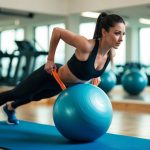
Structured Functional Workout Routines
Functional fitness focuses on exercises that mimic real-life movements. These workouts enhance agility, strength, and overall everyday performance. Structured routines efficiently incorporate varied exercises to achieve optimal benefits.
Designing a Functional Fitness Routine
When designing a functional fitness routine, it is crucial to incorporate diverse movements that target multiple muscle groups. Start by identifying specific goals, whether improving mobility, strength, or endurance. Including a mix of exercises such as squats, lunges, and push-ups ensures a well-rounded routine. Each session should aim for a balance of strength and cardio components.
Circuit training offers an efficient way to perform these exercises. It involves completing a series of workouts with minimal rest in between. This method keeps the heart rate up, providing both cardiovascular benefits and strength improvement. High-Intensity Interval Training (HIIT) can also be integrated for an added challenge. HIIT consists of short bursts of intense activity followed by rest, maximizing calorie burn and improving endurance.
Sample Functional Training Workouts
Sample functional training routines can offer a structured approach to integrating movements effectively. A balanced workout might begin with a warm-up, such as dynamic stretches, followed by circuits. For example, one circuit could include squats, push-ups, and kettlebell swings, performed for 30 seconds each with a 10-second rest.
Another routine might focus on mobility, using lunges, planks, and overhead presses. Each exercise can be adjusted based on fitness level, ensuring customization. Including a cool-down period with static stretching can aid recovery and help reduce muscle soreness.
Incorporating a variety of exercises not only prevents workout monotony but also continuously challenges different muscle groups. A consistent workout schedule with progressive overload ensures ongoing improvement and keeps motivation high.
Performance Metrics and Progression
Understanding performance metrics in functional fitness is crucial for evaluating improvements and guiding training strategies. These key metrics provide insights into athletic and sports performance. Setting specific goals, measuring progress, and tracking improvements are essential elements for achieving enhanced fitness results.
Setting and Achieving Fitness Goals
Setting clear fitness goals helps in maintaining focus and motivation. Specific goals, such as increasing endurance or enhancing strength, provide direction. They should be measurable, achievable, relevant, and time-bound. By aligning them with personal fitness standards, individuals can tailor their exercise routines.
Establishing short-term and long-term goals offers a comprehensive approach to progression. Short-term goals, achievable in weeks, build confidence and momentum. Long-term goals, set over months, guide overall fitness strategy. Regularly assessing these goals ensures that training remains aligned with desired outcomes.
Tracking Progress and Performance
Tracking performance is integral to functional fitness improvement. Tools like fitness apps and wearables measure progress efficiently. These include metrics such as heart rate variability, strength increments, or distance covered. Regularly reviewing this data helps highlight strengths and areas needing improvement.
Progression can also be assessed through periodic fitness testing. Evaluations like timed runs or weightlifting benchmarks measure improvements. Frequent monitoring allows individuals to adjust training intensity, ensuring continued growth. Adapting workouts based on performance data sustains motivation and drives results, fostering a successful fitness journey.
Enhancing Athletic Capabilities
Achieving excellence in athletic performance involves a focus on both speed and power. By honing these specific capabilities, athletes can elevate their game to new heights.
Speed and Agility Training
Speed training helps athletes achieve quicker movements and improved reaction times. Athletes benefit from incorporating sprint drills and interval training to enhance their speed. Agility is equally crucial as it aids in quick changes of direction. Techniques such as ladder drills and cone drills are effective in boosting agility.
Regular practice of these drills can lead to increased efficiency in movements. Consistent progress tracking allows for adjustments and improvements where needed. Warm-ups before engaging in these activities are vital to prevent injuries and ensure optimal performance. Proper rest between sessions is also essential for recovery and progress.
Power Development and Plyometrics
Power is an integral aspect that enables athletes to exert maximum force in the shortest time. Plyometric exercises, such as box jumps and depth jumps, are designed to increase this explosive power. These exercises help in refining muscle elasticity and coordination.
When performed correctly, they enhance both the lower and upper body strength. Timing and control are essential components of plyometrics. Gradually increasing the intensity and complexity of the exercises minimizes the risk of injury and maximizes benefits. Regular assessment ensures that techniques stay effective and align with athletic goals.



